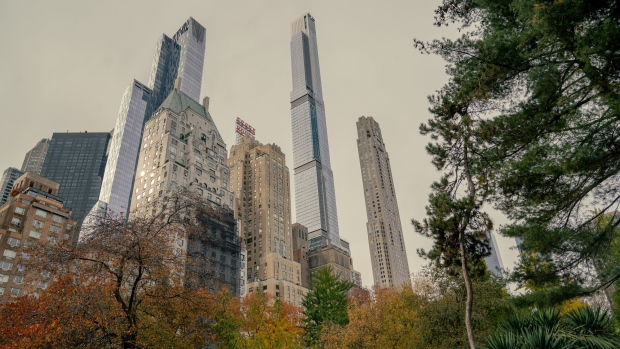Fancy Apartment Rentals for Paris Olympics See Poor Demand and Price Cuts
Locals who’d hoped to turn a big profit by renting out their posh apartments are now slashing prices by 30%-60%.
Latest Videos
The information you requested is not available at this time, please check back again soon.
Locals who’d hoped to turn a big profit by renting out their posh apartments are now slashing prices by 30%-60%.
The kingdom must overcome a conservative image and concern about human rights. Visit the desert oasis town of AlUla to understand the challenge.

Jury selection was completed Friday for Donald Trump’s first criminal trial, setting the stage for opening arguments Monday in a New York case accusing the former president of falsifying business records to conceal a sex scandal before the 2016 election.

Higher-than-expected interest rates amid persistent inflation are perceived as the biggest threat to financial stability among market participants and observers, according to the Federal Reserve.

Fifth Third Bancorp jumped the most in four months, leading bank stocks higher, with Chief Executive Officer Tim Spence predicting that income from lending has bottomed out.
Dec 23, 2021
, Bloomberg News

(Bloomberg) -- In case anyone was still worried about New York City being “over,” the news of its best-ever year in luxury home sales should put that concern permanently to rest.
Of the 1,877 contracts signed at $4 million and above, a staggering 400 were signed for properties asking $10 million or more, according to data compiled by Donna Olshan, president of the real estate broker Olshan Realty. “This has gone beyond the golden years of new development in 2013 and 2014 and 2015,” she says.
Olshan assembled a conditional list for Bloomberg of the 10 most expensive contracts signed—conditional, she says, because additional sales could emerge as the year draws to a close, and even after. “There are always going to be sales that aren’t reported, and they’re not in the database,” she explains.
Of the known sales to date, several clear trends have emerged.
The Upper East Side Is King
Including a penthouse sale at 1165 Madison that went into contract but hasn’t closed yet, nine of the top 10 sales listed by Olshan were located north of 57th street. “We don’t usually see that,” she says. “Usually this list is downtown-loaded.” In 2021, however, “uptown ruled the day.”
Chalk it up to the boom in new condos designed to look like old co-ops: The Robert AM Stern Architects (Ramsa)-designed 220 Central Park South occupied three of the top slots.
Related: Super-Luxury Home Sales Surge Across U.S., Rising 35% in 2021
Listed at No. 1 was a two-unit sale to Alibaba co-founder Joe Tsai for $157.5 million; No. 3 is a two-unit combination in the building that sold for $66 million; and slightly lower on the list (No. 5), a nearly 6,000-square-foot apartment that sold for $59.5 million, pushing that unit’s price per square foot just past $10,000.
The forthcoming sale at 1165 Madison Ave. (No. 2 on Olshan’s list, if it closes for the asking price of $66.5 million) was also designed by Stern to evoke the qualities of a prewar building.
Only one actual prewar unit made it onto the list: The triplex penthouse at 2 East 88th St., reportedly sold by banking scion Jacqui Safra, changed hands for $60 million, making it No. 4 on the list.
Next, three Upper East Side townhouses (Nos. 6, 7, and 8) added to the neighborhood’s total. Twelve East 69th St. sold for $59 million, 11 East 69th St. sold for $53.5 million, and 9 East 71st St., a 50-foot-wide townhouse once owned by Jeffrey Epstein, sold for $51 million.
Bigger Is Better
“The one result of the pandemic,” Olshan says, “is that everyone bought larger spaces.”
Everyone’s house was fine until it was no longer just a home. Suddenly, it was also an office and a school, which meant that “people wanted bigger, no matter what the price range,” she continues.
Leaving out 2 East 88th St., a co-op that doesn’t officially list its square footage—news reports pegged it at 7,000 square feet—the average square footage of the top apartments was just over 13,370 square feet.
The largest townhouse—9 East 71st St.—covers a massive 28,000 square feet. The largest condo, at 1165 Madison Ave., spans 13,000 square feet. “For rich people,” Olshan says, “there’s no such thing as being too rich, or too thin, or having too many rooms.”
The Sky’s Not Quite the Limit
For all the lofty prices of the Top 10 sales, several of the listings had to take significant price cuts before they sold.
The biggest price cut was reserved for a condo in the troubled Central Park Tower on West 57th Street, which initially carried a price tag of $95 million. (It’s No. 9 on the top 10 list.) The price was slashed 47% before it sold for $50 million, or $6,265 a square foot.
Epstein’s former house had a similar price trajectory: It sank from an ask of $88 million to one of $65 million. Its final price, at $51 million, was the bargain of the group, making the price per square foot a mere $1,821.
Twelve East 69th St. was also initially listed for $88 million, so its final price of $59 million represents a cut of nearly 38%.
“It’s aspirational pricing—fantasy pricing,” Olshan says. “But they’re still great numbers.”
They’re also numbers that Olshan predicts will continue to grow.
“If the stock market doesn’t blow out, or a variant doesn’t come and kill us, the demand will be there,” she says. “I think we’re OK for the first quarter of 2022. Beyond that, I don’t know.”
©2021 Bloomberg L.P.